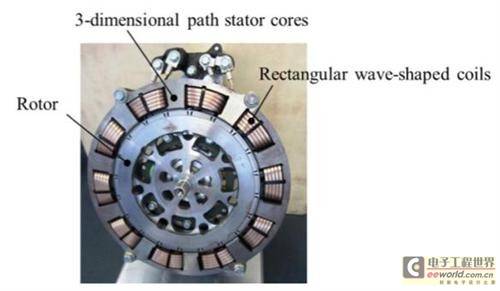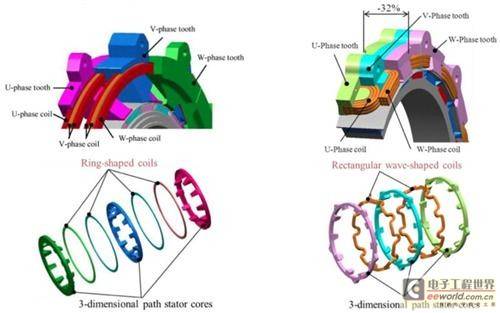In order to reduce the axial length of the motor in electric vehicles, Honda is currently developing a transverse flux motor with rectangular wave coils. At the 2013 Annual Meeting of Automotive Engineers, engineers explained the principle of this new three-dimensional flux motor.
Compared with conventional motors that use an iron core stator and winding wires, this transverse flux motor consists of a soft magnetic composite (SMC) stator and coils. This motor has only five parts in total, and it has raised new technical topics, namely how to further improve motor efficiency and the production and development technology of rectangular waveform coils.
Honda's IMA hybrid system places an electric motor between the internal combustion engine and the continuously variable transmission. The axial length of the motor increases the width of the powertrain. In order to make the IMA hybrid system convenient to install in more vehicle architectures, the axial length of the motor needs to be shortened, thereby shortening the overall width of the powertrain.
In order to shorten the axial length of the motor, engineers decided to start by reducing the length of the coil ends and proposed a transverse flux motor solution. Since the coil ends do not directly provide torque, they will not affect the performance of the motor. The initial transverse flux motor prototype used an internal toroidal coil. This design was later used to deal with the magnetic saturation short circuit phenomenon.
The stator of the salient pole concentrated winding motor contains 110 teeth, and the transverse flux motor forms a simple stator structure through a three-dimensional stator core and two rectangular waves.

However, due to the iron loss characteristics of soft magnetic composite materials, the motor efficiency of the original design was relatively low, with an electromagnetic efficiency of only 79.1%. In addition, the manufacturing process of rectangular coils is also different from that of circular coils. Therefore, engineers used rectangular wavy coils as a compromise solution.
In order to improve the efficiency of the motor, engineers studied the structure of the soft magnetic composite core and the production conditions parameters, and then obtained a solution to reduce magnetic losses. The magnetic losses caused by hysteresis losses and turbine losses in the motor will be suppressed.
To reduce hysteresis loss, the coercivity of iron powder needs to be reduced first. The main factors for the formation of coercivity are the grain boundaries of iron powder during compression and the tension of iron powder during compaction. Therefore, they tried to increase the volume of iron powder grains by annealing the iron powder and prevent the tension of iron powder from being too high by increasing the temperature of heat treatment after compaction.
Since the insulating coating will be destroyed during the compaction of the iron powder or the heat treatment at 650°C, the eddy current loss of the motor needs to be reduced and the iron powder of the insulating coating must be kept in its original state.
The transverse flux motor with rectangular wave coils is 32% shorter than the traditional transverse flux motor.
The compaction process of iron powder will damage the magnesium oxide coating, which can be alleviated by reducing the roughness of the iron powder surface and improving the fluidity during compaction. Therefore, engineers use centrifugal mills to reduce the roughness of the iron powder surface, increase the volume of resin binder and the amount of lubricant used to improve the fluidity of the iron powder during compaction.
The researchers used a coil protection film to meet the formability and insulation requirements of the rectangular wave coil. At the same time, they developed a winding and stamping process that can meet the needs of producing rectangular wave coils.
The coil film is made by die-casting, and its material is perfluoroalkoxy resin (PFA), which has good ductility and can help the coil film to be formed more quickly during the manufacturing process. When the coil winding is manufactured, the wires are scattered around the outside of the coil. Engineers use a three-dimensional movable stamping method to bend the original circular coil into a coil with rectangular waves, so the diameter of the coil is reduced with the same amount of material.
The prototype transverse flux motor manufactured has a peak torque of 140 Nm, and experiments have shown that its electromagnetic efficiency has been increased from 79.1% to 83.7%.
Previous article:Focus on driving experience Overview of the latest automotive interior and electrical technology
Next article:Fuji Heavy Industries' "XV Hybrid": Improving fuel efficiency using a stereo camera
- Popular Resources
- Popular amplifiers
- Car key in the left hand, liveness detection radar in the right hand, UWB is imperative for cars!
- After a decade of rapid development, domestic CIS has entered the market
- Aegis Dagger Battery + Thor EM-i Super Hybrid, Geely New Energy has thrown out two "king bombs"
- A brief discussion on functional safety - fault, error, and failure
- In the smart car 2.0 cycle, these core industry chains are facing major opportunities!
- The United States and Japan are developing new batteries. CATL faces challenges? How should China's new energy battery industry respond?
- Murata launches high-precision 6-axis inertial sensor for automobiles
- Ford patents pre-charge alarm to help save costs and respond to emergencies
- New real-time microcontroller system from Texas Instruments enables smarter processing in automotive and industrial applications
- LED chemical incompatibility test to see which chemicals LEDs can be used with
- Application of ARM9 hardware coprocessor on WinCE embedded motherboard
- What are the key points for selecting rotor flowmeter?
- LM317 high power charger circuit
- A brief analysis of Embest's application and development of embedded medical devices
- Single-phase RC protection circuit
- stm32 PVD programmable voltage monitor
- Introduction and measurement of edge trigger and level trigger of 51 single chip microcomputer
- Improved design of Linux system software shell protection technology
- What to do if the ABB robot protection device stops
- Allegro MicroSystems Introduces Advanced Magnetic and Inductive Position Sensing Solutions at Electronica 2024
- Car key in the left hand, liveness detection radar in the right hand, UWB is imperative for cars!
- After a decade of rapid development, domestic CIS has entered the market
- Aegis Dagger Battery + Thor EM-i Super Hybrid, Geely New Energy has thrown out two "king bombs"
- A brief discussion on functional safety - fault, error, and failure
- In the smart car 2.0 cycle, these core industry chains are facing major opportunities!
- The United States and Japan are developing new batteries. CATL faces challenges? How should China's new energy battery industry respond?
- Murata launches high-precision 6-axis inertial sensor for automobiles
- Ford patents pre-charge alarm to help save costs and respond to emergencies
- New real-time microcontroller system from Texas Instruments enables smarter processing in automotive and industrial applications
- Internet radio design based on RSIC-V RVB2601 (3)
- LIS2MDL three-axis magnetometer package and code
- Live broadcast with prizes: Enter the TI robot production class, starting on Friday, reservations are in progress! (Share 100% to get gifts)
- Do you have any use for STM8S005C6T6? Special price for delivery
- Explanation on DSP devices and general-purpose processors (GPP)
- Impedance matching of power amplifiers
- About electromagnetic shielding
- About Phase Modulation
- I am confused about K60, hope for your advice
- Coding and decoding of MSP430 infrared remote control


 LME49860MAX/NOPB
LME49860MAX/NOPB











 京公网安备 11010802033920号
京公网安备 11010802033920号